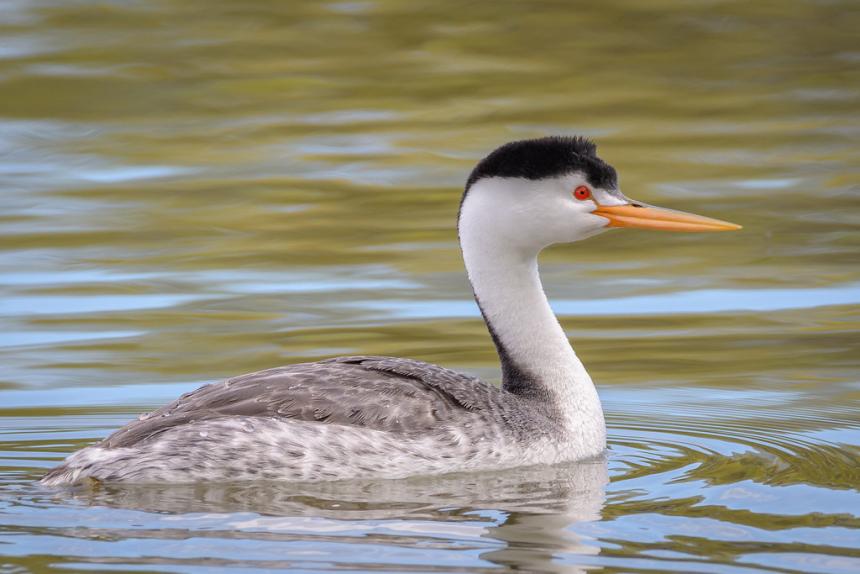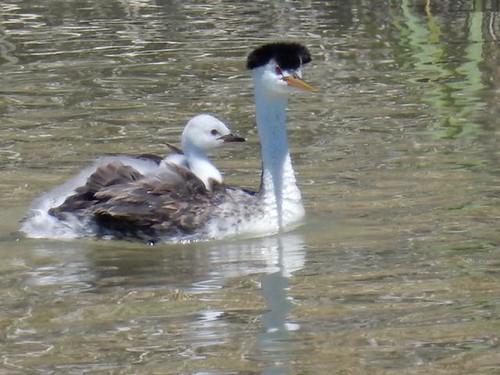Clark’s grebes occupy large freshwater lakes, reservoirs, and marshes during the summer breeding season and primarily coastal marine areas with relatively calm waters during the winter. The breeding population in Washington continues to be impacted by several major threats that are likely to keep numbers at reduced levels in the near future. Longer-term persistence of the population is of even greater concern.
Description and Range
Physical description
Clark's grebe is a about 25 inches in length and may be confused with western grebe. Clark’s and western grebes are closely related piscivorous (fish-eating) aquatic birds that once were considered different color phases of the same species, and they do occasionally interbreed. Clark’s grebe was recognized as a distinct species in 1985.
Like the western grebes, Clark's grebe has red eyes, a long neck, and lobed toes. Both grebes have a white throat and ear patch; white plumage extends down the underside of the throat and the underside of the body. However, the Clark’s grebe has a bright-yellow orange bill, and the black crown does not reach the eye.
Ecology and life history
Clark’s grebes occupy large freshwater lakes, reservoirs, and marshes during the summer breeding season and primarily coastal marine areas with relatively calm waters during the winter. Both types of habitats are used during spring and fall migration. Spring migration is mainly from late April to early May; fall migration extends from mid-September to November. Clark’s grebes will flock with western grebes.
Nesting areas typically contain at least several square kilometers of open water and areas of emergent vegetation. The species is gregarious, forming nesting colonies during the breeding season and sometimes occurring in flocks (often with western grebes) at other times of the year. Clark’s grebes are well known for their elaborate “rushing” courtship displays during the spring. Floating nests are made from and anchored to emergent vegetation. Clutch size usually numbers two to four eggs. Nesting and brood rearing extend from early June to late August.
Wintering birds can occur in daytime flocks, but disperse at night to forage. Fish comprise 80 percent to nearly 100 percent of the diet year-round, with numerous species eaten. Aquatic invertebrates are also consumed and are considered opportunistic as to the species eaten. Prey are caught underwater by diving.
Geographic range
Clark’s grebes breed at suitable water bodies across the western United States, southern Alberta to southern Manitoba, and Mexico. The species winters primarily along the Pacific coast from California to central Mexico.
All known breeding localities in Washington occur in Grant County except for one location in Adams County. Distribution in the state is more widespread during migration, including western Washington where the species is casual from September to May. The wintering range of Washington breeders is unknown.
For a map of range-wide distribution and other species' information, see NatureServe Explorer and the International Union for Conservation of Nature.
Climate vulnerability
Sensitivity to climate change
Moderate
This species is sensitive to fluctuating water level (high or low), which could lead to loss of eggs and nesting sites; in Washington, greater water drawdowns in reservoirs (i.e., because of expanded agricultural irrigation caused by climate change) may lead to increased nest loss. They may also be affected by potential changes in small fish and invertebrate prey species. Declines in pH could lead to declines in invertebrate prey and changes in water level in lakes and marshes could also lead to declines in available prey.
Exposure to climate change
Moderate
- Declines in pH
- Changes in water level (e.g., due to water drawdowns or declines in precipitation).
Conservation
Conservation Threats and Actions Needed
- Agriculture and aquaculture side effects
- Threat: Major water drawdowns at reservoirs used by nesting colonies.
- Action Needed: Devise effective floating nest platforms; work with irrigation authorities to manage water levels to reduce impacts to grebes.
- Fish and wildlife habitat loss or degradation
- Threat: Boater activity and boat wakes at nesting colonies can destroy nests, spill eggs, or cause gull predation.
- Action Needed: Identify wake-free zones near breeding colonies.
See the Climate vulnerability section for information about the threats posed by climate change to the Clark’s grebe.
Resources
References
Gaydos, J. K. and D. R. Nysewander. 2009. Draft Washington state status report for the Clark’s and Western Grebe. Washington Department of Fish and Wildlife, Olympia, Washington.
Hoenes, B. and R. Finger. 2011. Summary of Washington Department of Fish and Wildlife colonial waterbird surveys in Grant and Adams counties. Washington Department of Fish and Wildlife, Ephrata, Washington.
Mlodinow, S. G. 2005. Clark’s Grebe in western Washington. Western Birds 36:144-145.
Storer, R. W. and G. L. Nuechterlein. 1992. Western and Clark’s Grebes. Birds of North America 26: 1-24.
Wahl, T. R. 2005. Clark’s Grebe. Page 83 In T. R. Wahl, B. Tweit, and S. G. Mlodinow (eds.). Birds of Washington: Status and Distribution. Oregon State University Press, Corvallis, Oregon

